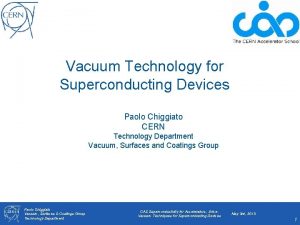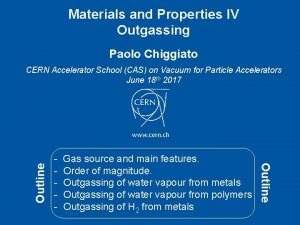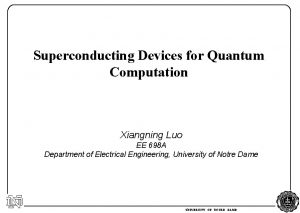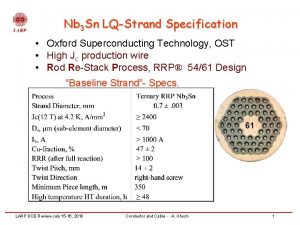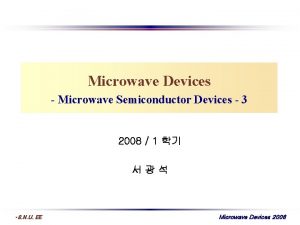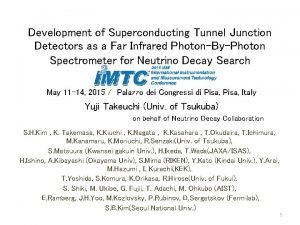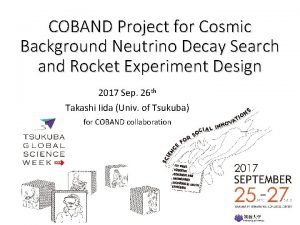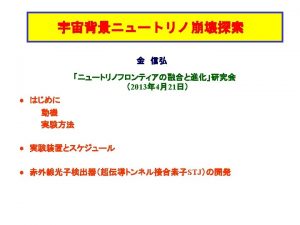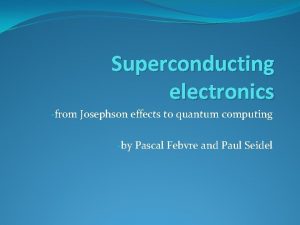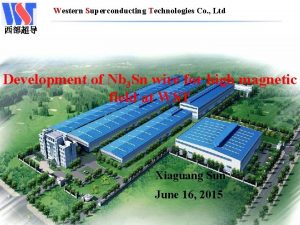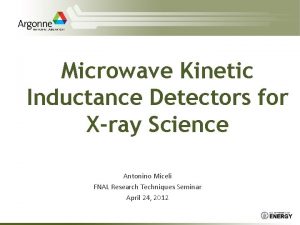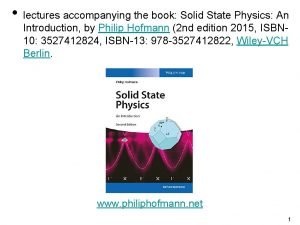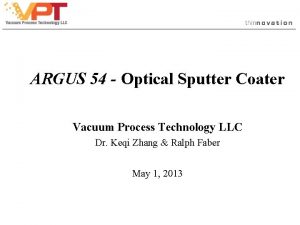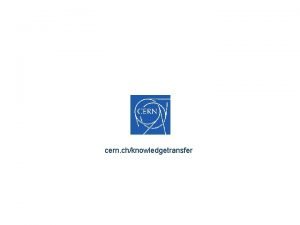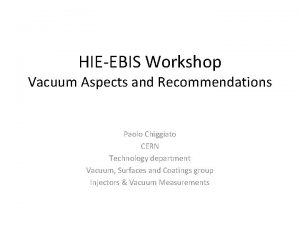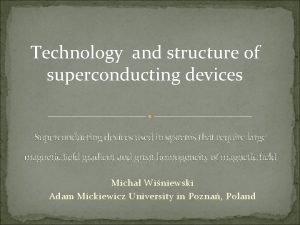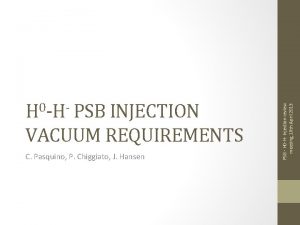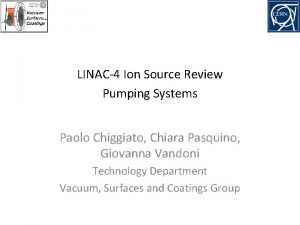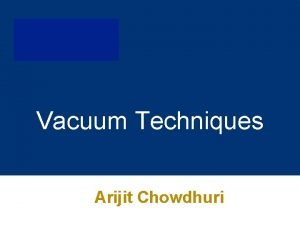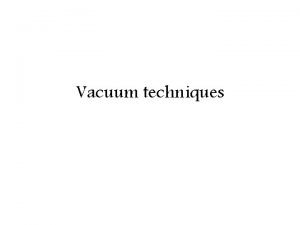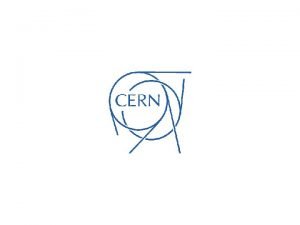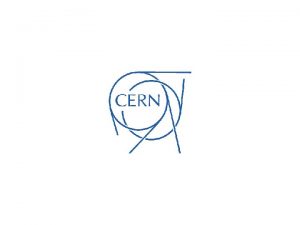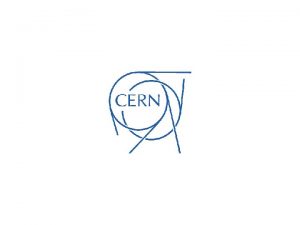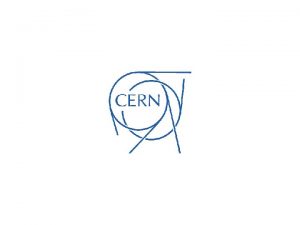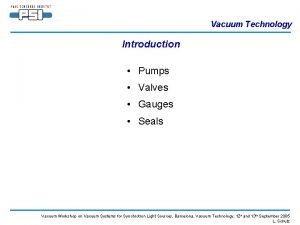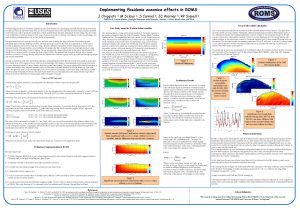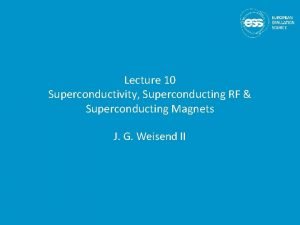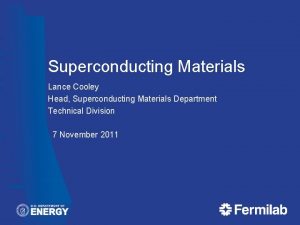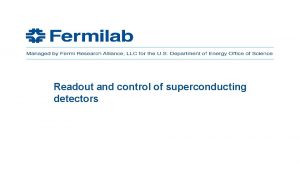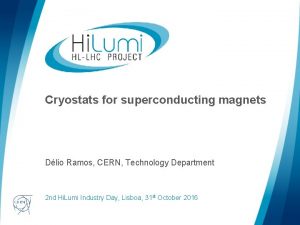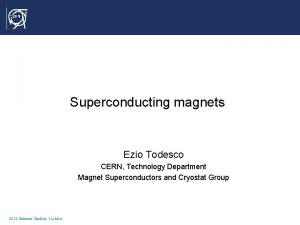Vacuum Technology for Superconducting Devices Paolo Chiggiato CERN











![Mass Transport at Low Pressure: Pumping Speed Maximum pumping speed [l s-1]for different circular Mass Transport at Low Pressure: Pumping Speed Maximum pumping speed [l s-1]for different circular](https://slidetodoc.com/presentation_image/59e76fe8c571726fde2ef7ec20dbbda3/image-12.jpg)


































































- Slides: 78

Vacuum Technology for Superconducting Devices Paolo Chiggiato CERN Technology Department Vacuum, Surfaces and Coatings Group Paolo Chiggiato Vacuum, Surfaces & Coatings Group Technology Department CAS Superconductivity for Accelerators, Erice. Vacuum Techniques for Superconducting Devices May 3 rd, 2013 1

Outline • Some definitions and degree of vacuum. • Thermal transport at low pressure. • Mass transport at low pressure: Appendices 1. Basic elements. 2. Numerical values for slides 6 and 7. v Conductance v Pumping speed. v Electrical analogy. • Gas sources: v Outgassing. v Inleakeage. • Pumping technologies: v Momentum transfer. v Capture pumps. 3. Numerical values of conductances. 4. Pressure profiles. 5. Outgassing values. 6. Complement of info about sputter ion pumps. 7. A few notes about cryopumps. • Pressure measurement in vacuum. Paolo Chiggiato Vacuum, Surfaces & Coatings Group Technology Department CAS Superconductivity for Accelerators, Erice. Vacuum Techniques for Superconducting Devices May 3 rd, 2013 2

Some Definitions and Degree of Vacuum for superconductivity in particle accelerators: 1. Thermal insulation for cryogenic systems. 2. Physical vapour deposition of superconducting thin films Pressure boundaries [mbar] Pressure boundaries [Pa] Low Vacuum LV 103 -1 105 -102 Medium Vacuum MV 1 -10 -3 102 -10 -1 High Vacuum HV 10 -3 -10 -9 10 -1 -10 -7 Ultra High vacuum UHV 10 -9 -10 -12 10 -7 -10 -10 <10 -12 <10 -10 Extreme Vacuum XHV Paolo Chiggiato Vacuum, Surfaces & Coatings Group Technology Department CAS Superconductivity for Accelerators, Erice. Vacuum Techniques for Superconducting Devices May 3 rd, 2013 3

Some Definitions and Degree of Vacuum The framework: 1. Ideal gas : 2. Maxwell-Boltzmann model: molecular mean speed impingement rate mean free path Knudsen number D is a characteristic dimension of a vacuum system (e. g. the diameter of a beam pipe). Paolo Chiggiato Vacuum, Surfaces & Coatings Group Technology Department CAS Superconductivity for Accelerators, Erice. Vacuum Techniques for Superconducting Devices May 3 rd, 2013 4

Some Definitions and Degree of Vacuum Kn range Regime Description The gas dynamics are dominated by molecular collisions with the walls of the system Kn >0. 5 Free molecular flow Kn <0. 01 Continuous (viscous) flow 0. 5<Kn <0. 01 Transitional flow The gas dynamics are dominated by intermolecular collisions Transition between molecular and viscous flow Both heat and mass transport are strongly dependent on the gas flow regime. Paolo Chiggiato Vacuum, Surfaces & Coatings Group Technology Department CAS Superconductivity for Accelerators, Erice. Vacuum Techniques for Superconducting Devices May 3 rd, 2013 5

Thermal Transport at Low Pressure Paolo Chiggiato Vacuum, Surfaces & Coatings Group Technology Department CAS Superconductivity for Accelerators, Erice. Vacuum Techniques for Superconducting Devices May 3 rd, 2013 6

Mass Transport at Low Pressure: Conductance Pressure difference Gas flow Conductance P 1 For N 2: T = 300 K Cylindrical duct L = 2 m; D = 0. 1 m In molecular: C ≈ 60 l/s In viscous: C ≈ 70000 l/s for P 1 -P 2 = 1000 Pa P 2 C depends on: molecular • Geometry of the duct regime • Mass of the gas molecule • Temperature of the gas • Viscosity • Pressure • Reynolds number viscous regime Conductances are much lower in molecular regime. Paolo Chiggiato Vacuum, Surfaces & Coatings Group Technology Department CAS Superconductivity for Accelerators, Erice. Vacuum Techniques for Superconducting Devices May 3 rd, 2013 7

Mass Transport at Low Pressure: Conductance Wall slot of area A and infinitesimal thickness; molecular regime: T, P 1 T, P 2 A In general, the transmission probability t is introduced: (see appendix 3, p. 53) Vessel 1 P 1 A 1 Vessel 2 P 2 A 2 Paolo Chiggiato Vacuum, Surfaces & Coatings Group Technology Department CAS Superconductivity for Accelerators, Erice. Vacuum Techniques for Superconducting Devices May 3 rd, 2013 8

Mass Transport at Low Pressure: Conductance roberto. kersevan@cern. ch http: //cern. ch/test-molflow Paolo Chiggiato Vacuum, Surfaces & Coatings Group Technology Department CAS Superconductivity for Accelerators, Erice. Vacuum Techniques for Superconducting Devices May 3 rd, 2013 9

Mass Transport at Low Pressure: Conductance C 1 P 1 C 2 P 2 P 3 For components placed in parallel (same pressures at the extremities): C 1 P 2 C 2 Paolo Chiggiato Vacuum, Surfaces & Coatings Group Technology Department CAS Superconductivity for Accelerators, Erice. Vacuum Techniques for Superconducting Devices May 3 rd, 2013 10

Mass Transport at Low Pressure: Pumping Speed vacuum vessel Ap pump aperture Paolo Chiggiato Vacuum, Surfaces & Coatings Group Technology Department CAS Superconductivity for Accelerators, Erice. Vacuum Techniques for Superconducting Devices May 3 rd, 2013 11
![Mass Transport at Low Pressure Pumping Speed Maximum pumping speed l s1for different circular Mass Transport at Low Pressure: Pumping Speed Maximum pumping speed [l s-1]for different circular](https://slidetodoc.com/presentation_image/59e76fe8c571726fde2ef7ec20dbbda3/image-12.jpg)
Mass Transport at Low Pressure: Pumping Speed Maximum pumping speed [l s-1]for different circular pump apertures vacuum vessel Ap pump aperture Paolo Chiggiato Vacuum, Surfaces & Coatings Group Technology Department ID [mm] H 2 N 2 Ar 36 448 120 100 63 1371 367 307 100 3456 924 773 150 7775 2079 1739 CAS Superconductivity for Accelerators, Erice. Vacuum Techniques for Superconducting Devices May 3 rd, 2013 12

Mass Transport at Low Pressure: Pumping Speed A gas flow restriction interposed between a pump and a vacuum vessel reduces the ‘useful’ pumping speed. The effective pumping speed Seff seen by the vacuum vessel is easily calculated: 500. 00 vacuum vessel 400. 00 vessel aperture C 1 Seff and C [l/s] P 1 Conductance S=250 l/s S=1000 l/s 300. 00 200. 00 100. 00 P 2 S pump aperture 0. 00 0 10 20 30 L/D Example Vessel and pump connected by a 100 mm diameter tube; N 2 , S=250 l/s and 1000 l/s. Paolo Chiggiato Vacuum, Surfaces & Coatings Group Technology Department CAS Superconductivity for Accelerators, Erice. Vacuum Techniques for Superconducting Devices May 3 rd, 2013 13

Efficient pumping? Paolo Chiggiato Vacuum, Surfaces & Coatings Group Technology Department CAS Superconductivity for Accelerators, Erice. Vacuum Techniques for Superconducting Devices May 3 rd, 2013 14

Mass Transport at Low Pressure: Transient Qin P Qout S P A = integration constant tp t Paolo Chiggiato Vacuum, Surfaces & Coatings Group Technology Department CAS Superconductivity for Accelerators, Erice. Vacuum Techniques for Superconducting Devices May 3 rd, 2013 15

Electrical analogy Vacuum element Conductance C Electrical elements Conductance 1/R Gas Flow Q Current I Pressure P Voltage V Capacitance C Volume V Conductance to ground Pump Current generator Gas source Constant pressure source Voltage supply Vacuum chamber with conductance and volume Paolo Chiggiato Vacuum, Surfaces & Coatings Group Technology Department CAS Superconductivity for Accelerators, Erice. Vacuum Techniques for Superconducting Devices May 3 rd, 2013 16

Electrical analogy Simple example: differential pumping Q A more complex example: part of the Linac 4 H- source (from C. Pasquino et al. , CERN, ATS/Note/2012/043 TECH) P 1 V 1 Q P 1 C V 2 V 1 S 1 Paolo Chiggiato Vacuum, Surfaces & Coatings Group Technology Department C P 2 V 2 S 2 CAS Superconductivity for Accelerators, Erice. Vacuum Techniques for Superconducting Devices May 3 rd, 2013 17

Gas Sources oils, dirt, …→ Cx. Hy, H 2 O, Cl, …→ Gross contamination Sorption layer (≈nm) ←solvents and/or ←detergents cleaning Mex. Oy, → Oxide layer (1 -10 nm) ← chemical pickling Damaged skin (10 -100 mm) ← etching and electropolishing excess dislocation, voids → Undamaged metal Courtesy of M. Taborelli Solvents: their molecules interact and transport contaminants away by diffusion (dilution) -> quite selective! (C 2 Cl 4, wide spectrum; HFC, more restricted action) Detergents in water: allows organics and water to combine by forming micelle (surfactant: surface acting agent ). Based on molecule with hydrophilic heads and lipophilic tail: less selective than solvents Paolo Chiggiato Vacuum, Surfaces & Coatings Group Technology Department CAS Superconductivity for Accelerators, Erice. Vacuum Techniques for Superconducting Devices May 3 rd, 2013 18

Gas Sources: Outgassing Any material in vacuum is a spontaneous source of gas. Paolo Chiggiato Vacuum, Surfaces & Coatings Group Technology Department CAS Superconductivity for Accelerators, Erice. Vacuum Techniques for Superconducting Devices May 3 rd, 2013 19

Gas Sources: Outgassing q (mbar l s− 1 cm− 2) Main gas species Neoprene, not baked, after 10 h of pumping order of 10− 5 H 2 O Viton, not baked, after 10 h of pumping order of 10− 7 H 2 O Austenitic stainless steel, not baked, after 10 h of pumping 3 × 10− 10 H 2 O Austenitic stainless steel, baked at 150°C for 24 h 3 × 10− 12 H 2 order of 10− 14 H 2 At room temperature Material OFS copper, baked at 200°C for 24 h The beam itself is also a source of gas. Electrons, photons, and ions colliding with the beam pipe surface stimulate gas desorption. Paolo Chiggiato Vacuum, Surfaces & Coatings Group Technology Department CAS Superconductivity for Accelerators, Erice. Vacuum Techniques for Superconducting Devices May 3 rd, 2013 20

Courtesy of P. Cruikshank For very thin polymer foils, the variation of the outgassing rate may be faster than 1/t: the dissolved water vapour is quickly removed. For an LHC insulation vacuum sector exposed to ambient air for several weeks, we obtain ~ 5 10 -3 mbar at RT after ~ 200 hrs pumping (S = 100 l/s, 250 m 2 of MLI per metre of length). Equivalent to ~ 10 -9 mbar. l. s-1. cm-2 per layer of MLI (equivalent to the outgassing rate of 2 soccer fields of stainless steel per metre of sector). Paolo Chiggiato Vacuum, Surfaces & Coatings Group Technology Department CAS Superconductivity for Accelerators, Erice. Vacuum Techniques for Superconducting Devices May 3 rd, 2013 21

Gas sources: Inleakage Other gas sources: virtual leaks → trapped air and impossible leak detection correct wrong vacuum air air Courtesy of L. Westerberg, CAS Vacuum 1999 vacuum air Skip weld outside for strength Courtesy of K. Zapfe, CAS Vacuum 2006 Paolo Chiggiato Vacuum, Surfaces & Coatings Group Technology Department CAS Superconductivity for Accelerators, Erice. Vacuum Techniques for Superconducting Devices May 3 rd, 2013 22

Gas Pumping Paolo Chiggiato Vacuum, Surfaces & Coatings Group Technology Department CAS Superconductivity for Accelerators, Erice. Vacuum Techniques for Superconducting Devices May 3 rd, 2013 23

Gas pumping: Momentum Transfer Pumps The molecules receive a momentum components pointing towards the pump outlet where the gas is compressed and finally evacuated by pumps working in viscous regime. S does not depend significantly on the mass of the molecule. Ko depends exponentially on the wall speed and square root of the gas molecule mass. Paolo Chiggiato Vacuum, Surfaces & Coatings Group Technology Department CAS Superconductivity for Accelerators, Erice. Vacuum Techniques for Superconducting Devices May 3 rd, 2013 24

Gas pumping: Momentum Transfer Pumps High compression ratio Courtesy of Pfeiffer Vacuum High pumping speed TMP pumping speeds are in the range from 10 l/s to 25, 000 l/s. Their ultimate pressure (H 2) is of the order of 10 -10, 10 -11 mbar Courtesy of Pfeiffer Vacuum http: //www. pfeiffer-vacuum. com Paolo Chiggiato Vacuum, Surfaces & Coatings Group Technology Department CAS Superconductivity for Accelerators, Erice. Vacuum Techniques for Superconducting Devices May 3 rd, 2013 25

Gas Pumping: Sputter Ion Pumps (SIP) • In SIP the residual gas is ionized in a Penning cell. • The ions are accelerated towards a cathode made of a reactive metal. • The collisions provoke sputtering of reactive-metal atoms that are deposited on the nearby surfaces. Paolo Chiggiato Vacuum, Surfaces & Coatings Group Technology Department CAS Superconductivity for Accelerators, Erice. Vacuum Techniques for Superconducting Devices May 3 rd, 2013 26

Gas Pumping: Sputter Ion Pumps (SIP) • The pumping action is given by: 1. chemical adsorption onto the reactive metal layer and subsequent burial by additional metallic atoms of gas molecules: all gases except rare gases 2. implantation of gas ions into the cathode and of energetic neutrals bounced back from the cathode into the deposited film: only mechanism of pumping for rare gases 3. diffusion into the cathode and the deposited film: only H 2 Paolo Chiggiato Vacuum, Surfaces & Coatings Group Technology Department CAS Superconductivity for Accelerators, Erice. Vacuum Techniques for Superconducting Devices May 3 rd, 2013 27

Gas Pumping: Getter Pumps Paolo Chiggiato Vacuum, Surfaces & Coatings Group Technology Department CAS Superconductivity for Accelerators, Erice. Vacuum Techniques for Superconducting Devices May 3 rd, 2013 28

Gas Pumping: Evaporable Getter Pumps For particle accelerators Ti is the sublimated metal. Ti alloy rods are heated up to 1500°C attaining a Ti vapour pressure of about 10 -3 mbar. Courtesy of Kurt J. Lesker Company http: //www. lesker. com/newweb/Vacuum_Pumps amax A K Gupta and J H Leek, Vacuum, 25(1975)362 Paolo Chiggiato Vacuum, Surfaces & Coatings Group Technology Department CAS Superconductivity for Accelerators, Erice. Vacuum Techniques for Superconducting Devices May 3 rd, 2013 29

Gas Pumping: Non-Evaporable Getter Pumps The dissolution of the oxide layer is possible only in metals having very high oxygen solubility limit, namely the elements of the 4 th group: Ti, Zr and Hf. T = Ta T = RT Surface oxide No pumping Paolo Chiggiato Vacuum, Surfaces & Coatings Group Technology Department T = RT Heating in vacuum Oxide layer dissolution-> activation CAS Superconductivity for Accelerators, Erice. Vacuum Techniques for Superconducting Devices Active surface Pumping May 3 rd, 2013 30

Gas Pumping: Non-Evaporable Getter Pumps The activation temperature of the 4 th group elements can be decreased by adding selected elements which increase oxygen diffusivity. NEG materials are produced industrially by powder technology. Small fragments are sintered to form pellets, discs or plates. The powder can also be pressed at room temperature on metallic ribbon. A typical alloy produced by SAES Getter is St 707: Element Concentration [wt. %] Zr 70 - High O solubility limit. - Chemical reactivity V 24. 6 - Increases O diffusivity, - Chemical reactivity Fe 5. 4 - Reduces pyrophoricity Main role in the alloy Full pumping speed is obtained after heating at 400°C for 45’ or 300°C for 24 h Paolo Chiggiato Vacuum, Surfaces & Coatings Group Technology Department CAS Superconductivity for Accelerators, Erice. Vacuum Techniques for Superconducting Devices May 3 rd, 2013 31

Gas Pumping: Non-Evaporable Getter Pumps Courtesy of SAES Getters, www. saesgetters. com The high porosity of NEG materials allows pumping of relatively high quantities of gas without reactivation. Paolo Chiggiato Vacuum, Surfaces & Coatings Group Technology Department CAS Superconductivity for Accelerators, Erice. Vacuum Techniques for Superconducting Devices May 3 rd, 2013 32

Gas Pumping: Non-Evaporable Getter Pumps Linear pumping may be obtained by NEG ribbons. LEP dipole vacuum chamber The first application was in the LEP. Paolo Chiggiato Vacuum, Surfaces & Coatings Group Technology Department CAS Superconductivity for Accelerators, Erice. Vacuum Techniques for Superconducting Devices May 3 rd, 2013 33

Gas Pumping: Non-Evaporable Getter Coatings NEG coating unit manifold Solenoid L=8 m f=60 cm 3 mm wires of Ti, Zr and V chambers extensions Paolo Chiggiato Vacuum, Surfaces & Coatings Group Technology Department CAS Superconductivity for Accelerators, Erice. Vacuum Techniques for Superconducting Devices May 3 rd, 2013 34

Gas Pumping: Non-Evaporable Getter Coatings Paolo Chiggiato Vacuum, Surfaces & Coatings Group Technology Department CAS Superconductivity for Accelerators, Erice. Vacuum Techniques for Superconducting Devices May 3 rd, 2013 35

Gas Pumping: Cryopumping relies on three different pumping mechanisms: 1. Cryocondensation: is based on the mutual attraction of similar molecules at low temperature: a. the key property is the saturated vapour pressure, i. e. the pressure of the gas phase in equilibrium with the condensate at a given temperature. It limits the attainable pressure. b. Only Ne, H 2 and He have saturated vapour pressures higher than 10 -11 mbar at 20 K. c. The vapour pressure of H 2 at 4. 3 K is in the 10 -7 mbar range, at 1. 9 lower than 10 -12 mbar. d. Large quantity of gas can be cryocondensed (limited only by thermal conductivity of the condensate phase and thermal flow) Courtesy of F. Dylla, CAS vacuum 2006 Paolo Chiggiato Vacuum, Surfaces & Coatings Group Technology Department CAS Superconductivity for Accelerators, Erice. Vacuum Techniques for Superconducting Devices May 3 rd, 2013 36

Gas Pumping: Cryopumping 2. Cryosorption: is based on the attraction between molecules and substrate. The interaction is much stronger than that between similar molecules: a) Gas molecules are pumped at pressures much lower than the saturated vapour pressure providing the adsorbed quantity is lower than one monolayer. a) Porous materials are used to increase the specific surface area; for charcoal about 1000 m 2 per gram are normally achieved. b) The important consequence is that significant quantities of H 2 can be pumped at 20 K and He at 4. 3 K. c) Submonolayer quantities of all gases may be effectively cryosorbed at their own boiling temperature; for example at 77 K all gases except He, H 2 and Ne. 3. Cryotrapping : low boiling point gas molecules are trapped in the layer of an easily condensable gas. The trapped gas has a saturation vapor pressure by several orders of magnitude lower than in the pure condensate. Examples: Ar trapped in CO 2 at 77 K; H 2 trapped in N 2 at 20 K. Paolo Chiggiato Vacuum, Surfaces & Coatings Group Technology Department CAS Superconductivity for Accelerators, Erice. Vacuum Techniques for Superconducting Devices May 3 rd, 2013 37

Gas Pumping: Cryopumping LHC beam vacuum in the arcs → Requirement: 100 h beam life time (nuclear scattering) equivalent to ~ 1015 H 2/m 3 (10 -8 mbar of H 2 at 300 K). 4. 2 K 1. 9 K Pumping capacity of He decreases by an order of magnitude between 1. 9 K and 4. 2 K Paolo Chiggiato Vacuum, Surfaces & Coatings Group Technology Department E. Wallén, J. Vac. Sci. Technol. A 15, 265 (1997) CAS Superconductivity for Accelerators, Erice. Vacuum Techniques for Superconducting Devices May 3 rd, 2013 38

Gas Pumping: Cryopumping → Main gas source: desorption stimulated by photon, electron and ion bombardment. → Pumping: Molecules with a low vapour pressure are first cryopumped onto the beam screen (CH 4, H 2 O, CO 2) and then onto the cold bore. Most of the H 2 is cryopumped onto the cold bore. Courtesy of V. Baglin Paolo Chiggiato Vacuum, Surfaces & Coatings Group Technology Department CAS Superconductivity for Accelerators, Erice. Vacuum Techniques for Superconducting Devices May 3 rd, 2013 39

Gas Pumping: Cryopumping In a few cases, the cold bore temperature is higher than 1. 9 K (stand alone magnets). H 2 adsorption isotherms High specific surface materials are used to cryosorb H 2. Pressure requirement Woven carbon fibers, developped at BINP Courtesy of V. Baglin Coverage limits : • 1018 H 2/cm 2 at 6 K • 1017 H 2/cm 2 at 30 K Paolo Chiggiato Vacuum, Surfaces & Coatings Group Technology Department CAS Superconductivity for Accelerators, Erice. Vacuum Techniques for Superconducting Devices May 3 rd, 2013 40

Pressure Measurement Physical phenomena Name of gauges Pressure range of gauge family Fields of application Advantages/ Limitations Force measurement due to DP • • Manometers. Mc. Leod. Bourdon. Capacitance. 10 -2 -105 Pa Metrology. Gas dosing. Gas line pressure. Absolute gauges Easy to use Viscous drag • Spinning rotor. 10 -4 -103 Pa Metrology. High precision Cost Gas dependence To be used by trained technicians Gas thermal conductivity • • Pirani. Thermocouple. 10 -1 -103 Rough Inexpensive measurement Limited precision during pump-down. Fast response Gas ionization • • • Bayard-Alpert Cold-cathode Extractor 10 -3 -10 -12 HV-UHV monitoring XHV measurement Paolo Chiggiato Vacuum, Surfaces & Coatings Group Technology Department CAS Superconductivity for Accelerators, Erice. Vacuum Techniques for Superconducting Devices Low pressure BA: X-ray limitation Sensitive to contamination May 3 rd, 2013 41

Conclusion First Nb thin-film coated Cu cavity, at CERN by the Cris Benvenuti team in 1983. The sputtering technique was used for the RF SC cavities of LEP 2. The experience in UHV technology achieved by the team during the ISR construction and upgrade was a key factor of their success. On the other hand, the experience in Nb thin films led to the invention of Non. Evaporable Getter thin film coatings Paolo Chiggiato Vacuum, Surfaces & Coatings Group Technology Department CAS Superconductivity for Accelerators, Erice. Vacuum Techniques for Superconducting Devices May 3 rd, 2013 42

Acknowledgements I wish to thank all my colleagues of the Vacuum, Surfaces and Coatings group of the Technology Department at CERN, including students and visitors. The VSC group has become a centre of excellence in Europe encompassing all aspects of vacuum technology, from surface treatments to computation, operation and control of unique facilities. I am indebted with Giovanna Vandoni, Chiara Pasquino, Roberto Kersevan, and Jose Antonio Ferreira Somoza for their kind corrections of this lecture. Paolo Chiggiato Vacuum, Surfaces & Coatings Group Technology Department CAS Superconductivity for Accelerators, Erice. Vacuum Techniques for Superconducting Devices May 3 rd, 2013 43


Appendices Paolo Chiggiato Vacuum, Surfaces & Coatings Group Technology Department CAS Superconductivity for Accelerators, Erice. Vacuum Techniques for Superconducting Devices May 3 rd, 2013 45

Appendix 1: Basic Elements, Pressure Units In vacuum technology: mbar or Pa Still used in vacuum technology (particularly in USA): Torr 1 Torr → pressure exerted by a column of 1 mm of Hg, 1 atm = 760 Torr Conversion Table Pa bar atm Torr 1 Pa 1 10 -5 9. 87 10 -6 7. 5 10 -3 1 bar 105 1 0. 987 750. 06 1 atm 1. 013 105 1. 013 1 760 1 Torr 133. 32 1. 33 10 -3 1. 32 10 -3 1 Paolo Chiggiato Vacuum, Surfaces & Coatings Group Technology Department CAS Superconductivity for Accelerators, Erice. Vacuum Techniques for Superconducting Devices May 3 rd, 2013 46

Appendix 1: Basic Elements, Gas Density Pressure (Pa) Atmospheric pressure at sea level Typical plasma chambers 293 K (molecules cm− 3) 1. 013 × 105 2. 5 × 1019 4. 3 K (molecules cm− 3) 1. 7 × 1021 1 2. 5 × 1014 1. 7 × 1016 LHC experimental beam pipes 10− 9 2. 5 × 105 1. 7 × 107 Lowest pressure ever measured at room temperature 10− 12 250 1. 7 × 104 Paolo Chiggiato Vacuum, Surfaces & Coatings Group Technology Department CAS Superconductivity for Accelerators, Erice. Vacuum Techniques for Superconducting Devices May 3 rd, 2013 47

Appendix 1: Basic Elements, Mean speed of a molecule Courtesy of Wikipedia: http: //en. wikipedia. org/wiki /Maxwell%E 2%80%93 Boltzmann_distribution Gas H 2 1761 213 He 1244 151 CH 4 622 75 N 2 470 57 Ar 394 48 Paolo Chiggiato Vacuum, Surfaces & Coatings Group Technology Department CAS Superconductivity for Accelerators, Erice. Vacuum Techniques for Superconducting Devices May 3 rd, 2013 48

Appendix 1: Basic Elements, Impingement rate Gas H 2 N 2 Ar Paolo Chiggiato Vacuum, Surfaces & Coatings Group Technology Department Pressure [mbar] Impingement rate 293 K [cm-2 s-1] 10 -3 1. 1 1018 10 -8 1. 1 1013 10 -14 1. 1 107 10 -3 2. 9 1017 10 -8 2. 9 1012 10 -3 2. 4 1017 10 -8 2. 4 1012 CAS Superconductivity for Accelerators, Erice. Vacuum Techniques for Superconducting Devices May 3 rd, 2013 49

Appendix 1: Basic Elements, Mean Free Path Gas Paolo Chiggiato Vacuum, Surfaces & Coatings Group Technology Department H 2 0. 27 He 0. 21 N 2 0. 43 O 2 0. 40 CO 2 0. 52 CAS Superconductivity for Accelerators, Erice. Vacuum Techniques for Superconducting Devices May 3 rd, 2013 50

Appendix 1: Basic Elements, Mean Free Path Earth diameter Moon-Earth distance Paris-New York distance LHC circumference Typical dimensions of laboratory vacuum systems Kn≈1 1 mbar = 100 Pa Paolo Chiggiato Vacuum, Surfaces & Coatings Group Technology Department CAS Superconductivity for Accelerators, Erice. Vacuum Techniques for Superconducting Devices May 3 rd, 2013 51

Appendix 2: Numerical values for slide No. 6 Conduction in viscous regime For diatomic molecules: Conduction in molecular regime N 2 Radiation Paolo Chiggiato Vacuum, Surfaces & Coatings Group Technology Department CAS Superconductivity for Accelerators, Erice. Vacuum Techniques for Superconducting Devices May 3 rd, 2013 52

Appendix 2: Numerical values for slide No. 7 L P 1 P 2 D Poiseuille equation for long circular pipes in viscous regime: For N 2: d = 370 pm m = 4. 6 x 10 -26 Kg T = 300 K P 1 -P 2 = 1000 Pa L = 2 m; D = 0. 1 m Paolo Chiggiato Vacuum, Surfaces & Coatings Group Technology Department CAS Superconductivity for Accelerators, Erice. Vacuum Techniques for Superconducting Devices May 3 rd, 2013 53

Appendix 3: Numerical Values of Conductances Wall slot of area A and infinitesimal thickness; molecular regime: T, P 2 T, P 1 A For other gas flow restrictions, the transmission probability t is introduced: Vessel 1 P 1 A 1 Vessel 2 P 2 A 2 Paolo Chiggiato Vacuum, Surfaces & Coatings Group Technology Department CAS Superconductivity for Accelerators, Erice. Vacuum Techniques for Superconducting Devices May 3 rd, 2013 54

Appendix 3: Numerical Values of Conductances T= 293 K Gas H 2 1761 440. 25 44 He 1244 311 31. 1 CH 4 622 155. 5 15. 5 H 2 O 587 146. 7 14. 7 N 2 470 117. 5 11. 75 Ar 394 98. 5 9. 85 P 1 A P 2 Paolo Chiggiato Vacuum, Surfaces & Coatings Group Technology Department CAS Superconductivity for Accelerators, Erice. Vacuum Techniques for Superconducting Devices May 3 rd, 2013 55

Appendix 3: Numerical Values of Conductances Paolo Chiggiato Vacuum, Surfaces & Coatings Group Technology Department CAS Superconductivity for Accelerators, Erice. Vacuum Techniques for Superconducting Devices May 3 rd, 2013 56

Appendix 3: Numerical Values of Conductances Paolo Chiggiato Vacuum, Surfaces & Coatings Group Technology Department CAS Superconductivity for Accelerators, Erice. Vacuum Techniques for Superconducting Devices May 3 rd, 2013 57

Appendix 4: Pressure Profiles Q Q C 1 P S C 2 C 3 P 1 P 2 P 3 P 4 S 1 S 2 S 3 S 4 Flux balance at the connexions (node analysis): Q P C Q Cx S x L Paolo Chiggiato Vacuum, Surfaces & Coatings Group Technology Department S CAS Superconductivity for Accelerators, Erice. Vacuum Techniques for Superconducting Devices May 3 rd, 2013 58

Appendix 4: Pressure Profiles Pressure profiles with distributed outgassing can be calculated analytically (for simple geometry), by electrical analogy or by Monte Carlo simulation. P(x) x Distributed outgassing P(0) x S L P(x) x x+Dx PMAX x Distributed outgassing P(0) x S L Paolo Chiggiato Vacuum, Surfaces & Coatings Group Technology Department S CAS Superconductivity for Accelerators, Erice. Vacuum Techniques for Superconducting Devices May 3 rd, 2013 59

Appendix 4: Pressure Profiles, Time Variation (with reference to slide 15 and 60) A = integration constant Q P For a network of vacuum chambers, systems of coupled differential equations for each chamber have to be solved. t t However, a simpler method exists. It is based on the analogy between vacuum systems and electrical networks. Very powerful software is available for the time dependent analysis of electrical networks. Paolo Chiggiato Vacuum, Surfaces & Coatings Group Technology Department CAS Superconductivity for Accelerators, Erice. Vacuum Techniques for Superconducting Devices May 3 rd, 2013 60

Appendix 5: Outgassing of Water Vapour for Metals Outgassing rate of water vapour for unbaked metals H. F. Dylla, D. M. Manos, P. H. La. Marche Jr. Journal of Vacuum Science and Tech. A, 11(1993)2623 Paolo Chiggiato Vacuum, Surfaces & Coatings Group Technology Department CAS Superconductivity for Accelerators, Erice. Vacuum Techniques for Superconducting Devices May 3 rd, 2013 61

Appendix 5: Outgassing Rates of Polymers Outgassing rate of water vapour for polymers R. N. Peacock, J. Vac. Sci. Technol. , 17(1), p. 330, 1980 10 -6 unbaked Viton Stainless Steel after 10 h pumping: 2 x 10 -10 Torr l s-1 cm-2 baked Viton 10 -10 Paolo Chiggiato Vacuum, Surfaces & Coatings Group Technology Department CAS Superconductivity for Accelerators, Erice. Vacuum Techniques for Superconducting Devices May 3 rd, 2013 62

Old mo lecu lar p ump Appendix 6: Momentum Transfer Pumps To overcome the problem of the required narrow pump duct, in 1957 Backer introduced the turbomolecular pumps (TMP) based on rapidly rotating blades. Paolo Chiggiato Vacuum, Surfaces & Coatings Group Technology Department CAS Superconductivity for Accelerators, Erice. Vacuum Techniques for Superconducting Devices May 3 rd, 2013 63

Appendix 6: Sputter Ion Pumps (SIP) Diode Triode Two different configurations: - Diode - Triode: better pumping for noble gas (see appendix 6, p. 65) K. M. Welch, Capture Pumping Technology, North-Holland, p. 113 An improved triode ion pump is the Star. Cell (Agilent Vacuum) Paolo Chiggiato Vacuum, Surfaces & Coatings Group Technology Department CAS Superconductivity for Accelerators, Erice. Vacuum Techniques for Superconducting Devices May 3 rd, 2013 64

Appendix 6: Sputter Ion Pumps (SIP) Pumping speed for SIP depends on the pressure at the pump inlet and the nature of the gas. Nominal pumping speed for N 2: Agilent starcell DN Paolo Chiggiato Vacuum, Surfaces & Coatings Group Technology Department S [ l s-1] GAS DIODE PUMPS TRIODE PUMPS AIR 1 1 N 2 1 1 O 2 1 1 H 2 1. 5 -2 CO 0. 9 CO 2 0. 9 H 2 O 0. 8 CH 4 0. 6 -1 63 50 Ar 0. 03 0. 25 100 70/125 He 0. 1 0. 3 150 240/500 Pumping speed normalized to air CAS Superconductivity for Accelerators, Erice. Vacuum Techniques for Superconducting Devices May 3 rd, 2013 65

Appendix 6: Triode Sputter Ion Pumps An excessive quantity of noble gas implanted in the cathode can produce pressure instabilities (Ar disease): • the continuous erosion extract noble gas atoms from the cathode; • as a result the pressure increases and the erosion is accelerated; • a pressure rise is obtained, which terminate when most of the gas is implanted again in the sputtered film or in a deeper zone of the cathode. Kimo M. Welch, Capture Pumping Technology, North-Holland, p. 106 Paolo Chiggiato Vacuum, Surfaces & Coatings Group Technology Department CAS Superconductivity for Accelerators, Erice. Vacuum Techniques for Superconducting Devices May 3 rd, 2013 66

Appendix 6: Triode Sputter Ion Pumps Paolo Chiggiato Vacuum, Surfaces & Coatings Group Technology Department CAS Superconductivity for Accelerators, Erice. Vacuum Techniques for Superconducting Devices May 3 rd, 2013 67

Appendix 6: H 2 Pumping by Sputter Ion Pumps Paolo Chiggiato Vacuum, Surfaces & Coatings Group Technology Department CAS Superconductivity for Accelerators, Erice. Vacuum Techniques for Superconducting Devices May 3 rd, 2013 68

Appendix 6: Operation of Sputter Ion Pumps • • • High Pressure Operation thermal run-away. It is frequently noticeable during the pumping of H 2 or after the absorption of high quantity of H 2 (for example due to pumping of H 2 O). The Penning discharge heats the cathode and provokes gas desorption, which enhance the discharge. This positive feedback mechanism can melt locally the cathode. The total electrical power given to the pump has to be limited at high pressure. High pressure (>10 -5 mbar) operation can generate Courtesy of Agilent Vacuum Pressure measurement by ion pumps The discharge current of the penning cells can be used for pressure measurement. In the low pressure range, the current measurement is limited by field emission (leakage current): pressure reading is limited in the 10 -9 mbar range. By reducing the applied voltage in the lower pressure range, the pressure measurement is possible down to 10 -10 mbar. Paolo Chiggiato Vacuum, Surfaces & Coatings Group Technology Department CAS Superconductivity for Accelerators, Erice. Vacuum Techniques for Superconducting Devices May 3 rd, 2013 69

Appendix 7: Cryopumps Modern cryopumps take advantages of both cryocondensation and cryosorption. 1. The cryocondensation takes place on a cold surfaces, in general at 80 K for H 2 O and 10 or 20 K for the other gases. 2. The cryosorption of H 2, Ne and He is localised on a hidden surface where a porous material is fixed. This surface is kept away from the reach of the other molecules. 80 K 20 K Helium is the working fluid of refrigerators. Paolo Chiggiato Vacuum, Surfaces & Coatings Group Technology Department CAS Superconductivity for Accelerators, Erice. Vacuum Techniques for Superconducting Devices May 3 rd, 2013 70

Appendix 7: Cryopumps require periodic regeneration to evacuate the gas adsorbed or condensed. To remove all captured gas, the pump is warmed at room temperature. The desorbed gas is removed by mechanical pumps (in general, for accelerators, mobile TMP). During regeneration, the rest of the system shall be separated by a valve. In the majority of application, the performance deterioration is given by the gas adsorbed on the second stage (10 -20 K). A partial regeneration may be carried out for a shorter time while water vapour is kept on the first stage at temperatures lower than 140 K. Paolo Chiggiato Vacuum, Surfaces & Coatings Group Technology Department CAS Superconductivity for Accelerators, Erice. Vacuum Techniques for Superconducting Devices May 3 rd, 2013 71

Appendix 7: Cryopumps Characteristics of Cryopumps 1. Starting Pressure • Cryopumps should be started when the mean free path of molecules is higher than the pump vessel diameter: P<10 -3 mbar. Otherwise thermal load is too high. • In addition a thick condensate layer must be avoided. • They need auxiliary pumps. 2. Pumping speed • High effective pumping speed for all gases. Pumping speed from 800 l/s up to 60000 l/s are commercially available. • Pumping speed for water vapour close to theoretical maximum. 3. Maximum Gas Intake (Capacity) • • • At the maximum gas intake, the initial pumping speed of the gas is reduced by a factor of 2. Condensed gases: the limitation is given by thermal conductivity of the gas layer and the heat flux on the cold surface. Adsorbed gases: the capacity depends on the quantity and properties of the sorption agent; the capacity is pressure dependent and generally several orders of magnitude lower than that of condensable gases. Paolo Chiggiato Vacuum, Surfaces & Coatings Group Technology Department CAS Superconductivity for Accelerators, Erice. Vacuum Techniques for Superconducting Devices May 3 rd, 2013 72

Spare Slides Paolo Chiggiato Vacuum, Surfaces & Coatings Group Technology Department CAS Superconductivity for Accelerators, Erice. Vacuum Techniques for Superconducting Devices May 3 rd, 2013 73

Gas Sources: Inleakeage Good practice: avoid trapped liquids air vacuum Trapped liquids could be harmful even on the external parts of thin-wall components: corrosion! vacuum air Paolo Chiggiato Vacuum, Surfaces & Coatings Group Technology Department CAS Superconductivity for Accelerators, Erice. Vacuum Techniques for Superconducting Devices May 3 rd, 2013 74

Courtesy of C. Hauviller (copied from his presentation at CAS Vacuum 2006) Paolo Chiggiato Vacuum, Surfaces & Coatings Group Technology Department CAS Superconductivity for Accelerators, Erice. Vacuum Techniques for Superconducting Devices May 3 rd, 2013 75

Paolo Chiggiato Vacuum, Surfaces & Coatings Group Technology Department CAS Superconductivity for Accelerators, Erice. Vacuum Techniques for Superconducting Devices May 3 rd, 2013 76

Pumping Speed of Turbomolecular Pumps (TMP) Courtesy of Pfeiffer Vacuum http: //www. pfeiffer-vacuum. com Vacuum Technology Know-how Paolo Chiggiato Vacuum, Surfaces & Coatings Group Technology Department CAS Superconductivity for Accelerators, Erice. Vacuum Techniques for Superconducting Devices May 3 rd, 2013 77

Paolo Chiggiato Vacuum, Surfaces & Coatings Group Technology Department CAS Superconductivity for Accelerators, Erice. Vacuum Techniques for Superconducting Devices May 3 rd, 2013 78
 Paolo chiggiato
Paolo chiggiato Paolo chiggiato
Paolo chiggiato Superconducting devices in quantum optics
Superconducting devices in quantum optics Oxford superconducting technology
Oxford superconducting technology Superconducting tunnel junction
Superconducting tunnel junction Stj
Stj Superconducting tunnel junction
Superconducting tunnel junction Superconducting tunnel junction
Superconducting tunnel junction Superconducting electronics
Superconducting electronics Western superconducting
Western superconducting Superconducting
Superconducting Superconducting energy gap
Superconducting energy gap Meissner effect equation
Meissner effect equation Vacuum process technology
Vacuum process technology Cern technology transfer
Cern technology transfer Iso 22301 utbildning
Iso 22301 utbildning Novell typiska drag
Novell typiska drag Tack för att ni lyssnade bild
Tack för att ni lyssnade bild Ekologiskt fotavtryck
Ekologiskt fotavtryck Varför kallas perioden 1918-1939 för mellankrigstiden
Varför kallas perioden 1918-1939 för mellankrigstiden En lathund för arbete med kontinuitetshantering
En lathund för arbete med kontinuitetshantering Kassaregister ideell förening
Kassaregister ideell förening Personlig tidbok
Personlig tidbok Sura för anatom
Sura för anatom Förklara densitet för barn
Förklara densitet för barn Datorkunskap för nybörjare
Datorkunskap för nybörjare Stig kerman
Stig kerman Mall för debattartikel
Mall för debattartikel Magnetsjukhus
Magnetsjukhus Nyckelkompetenser för livslångt lärande
Nyckelkompetenser för livslångt lärande Påbyggnader för flakfordon
Påbyggnader för flakfordon Arkimedes princip formel
Arkimedes princip formel Offentlig förvaltning
Offentlig förvaltning Jag har nigit för nymånens skära
Jag har nigit för nymånens skära Presentera för publik crossboss
Presentera för publik crossboss Vad är ett minoritetsspråk
Vad är ett minoritetsspråk Kanaans land
Kanaans land Klassificeringsstruktur för kommunala verksamheter
Klassificeringsstruktur för kommunala verksamheter Mjälthilus
Mjälthilus Claes martinsson
Claes martinsson Centrum för kunskap och säkerhet
Centrum för kunskap och säkerhet Verifikationsplan
Verifikationsplan Bra mat för unga idrottare
Bra mat för unga idrottare Verktyg för automatisering av utbetalningar
Verktyg för automatisering av utbetalningar Rutin för avvikelsehantering
Rutin för avvikelsehantering Smärtskolan kunskap för livet
Smärtskolan kunskap för livet Ministerstyre för och nackdelar
Ministerstyre för och nackdelar Tack för att ni har lyssnat
Tack för att ni har lyssnat Hur ser ett referat ut
Hur ser ett referat ut Redogör för vad psykologi är
Redogör för vad psykologi är Stål för stötfångarsystem
Stål för stötfångarsystem Tack för att ni har lyssnat
Tack för att ni har lyssnat Borra hål för knoppar
Borra hål för knoppar Vilken grundregel finns det för tronföljden i sverige?
Vilken grundregel finns det för tronföljden i sverige? Hur räknar man standardavvikelse
Hur räknar man standardavvikelse Tack för att ni har lyssnat
Tack för att ni har lyssnat Steg för steg rita
Steg för steg rita Verksamhetsanalys exempel
Verksamhetsanalys exempel Tobinskatten för och nackdelar
Tobinskatten för och nackdelar Blomman för dagen drog
Blomman för dagen drog Gibbs reflekterande cykel
Gibbs reflekterande cykel Egg för emanuel
Egg för emanuel Elektronik för barn
Elektronik för barn Plagg i rom
Plagg i rom Strategi för svensk viltförvaltning
Strategi för svensk viltförvaltning Var 1721 för stormaktssverige
Var 1721 för stormaktssverige Ellika andolf
Ellika andolf Ro i rom pax
Ro i rom pax Tack för att ni lyssnade
Tack för att ni lyssnade Mindre än tecken
Mindre än tecken Dikt bunden form
Dikt bunden form Inköpsprocessen steg för steg
Inköpsprocessen steg för steg Fuktmätningar i betong enlig rbk
Fuktmätningar i betong enlig rbk Ledarskapsteorier
Ledarskapsteorier Expektans eller exspektans
Expektans eller exspektans Myndigheten för delaktighet
Myndigheten för delaktighet Frgar
Frgar Sju principer för tillitsbaserad styrning
Sju principer för tillitsbaserad styrning Läkarutlåtande för livränta
Läkarutlåtande för livränta
